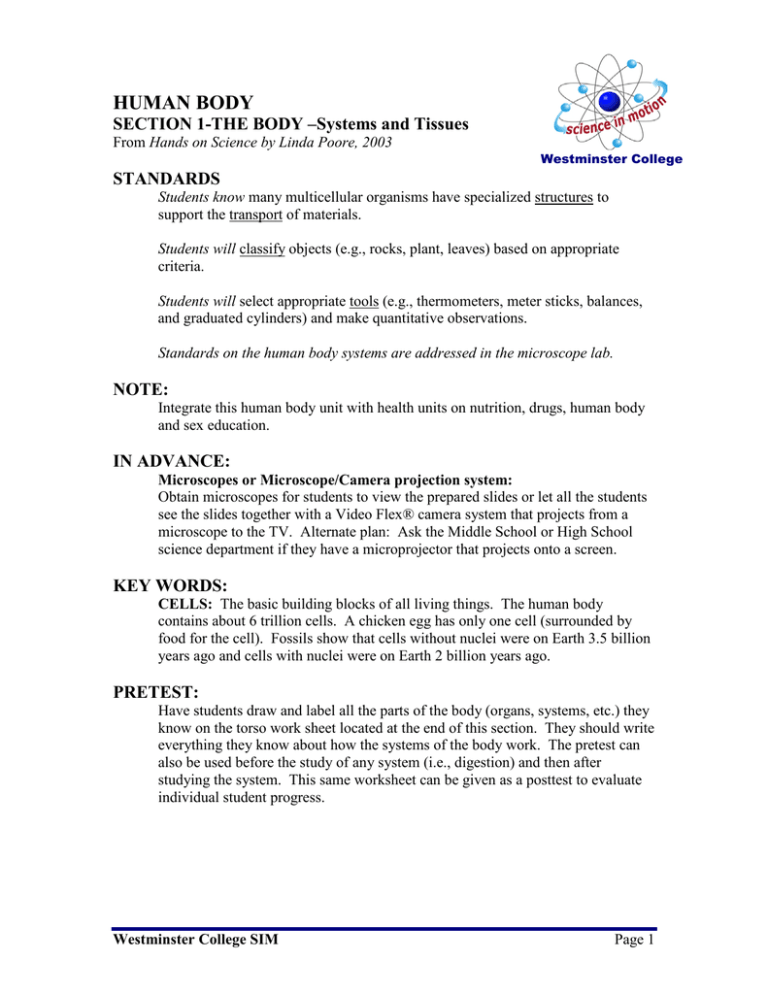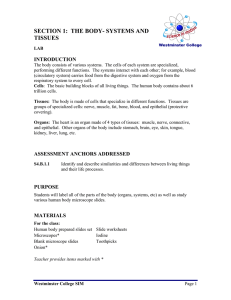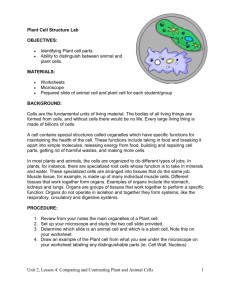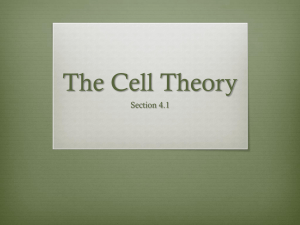HUMAN BODY SECTION 1-THE BODY –Systems and Tissues STANDARDS
advertisement

HUMAN BODY SECTION 1-THE BODY –Systems and Tissues From Hands on Science by Linda Poore, 2003 Westminster College STANDARDS Students know many multicellular organisms have specialized structures to support the transport of materials. Students will classify objects (e.g., rocks, plant, leaves) based on appropriate criteria. Students will select appropriate tools (e.g., thermometers, meter sticks, balances, and graduated cylinders) and make quantitative observations. Standards on the human body systems are addressed in the microscope lab. NOTE: Integrate this human body unit with health units on nutrition, drugs, human body and sex education. IN ADVANCE: Microscopes or Microscope/Camera projection system: Obtain microscopes for students to view the prepared slides or let all the students see the slides together with a Video Flex® camera system that projects from a microscope to the TV. Alternate plan: Ask the Middle School or High School science department if they have a microprojector that projects onto a screen. KEY WORDS: CELLS: The basic building blocks of all living things. The human body contains about 6 trillion cells. A chicken egg has only one cell (surrounded by food for the cell). Fossils show that cells without nuclei were on Earth 3.5 billion years ago and cells with nuclei were on Earth 2 billion years ago. PRETEST: Have students draw and label all the parts of the body (organs, systems, etc.) they know on the torso work sheet located at the end of this section. They should write everything they know about how the systems of the body work. The pretest can also be used before the study of any system (i.e., digestion) and then after studying the system. This same worksheet can be given as a posttest to evaluate individual student progress. Westminster College SIM Page 1 THE BODY-SYSTEMS AND TISSUES MATERIALS human body prepared slides set slide description sheets and work sheet (end of this section) microscopes or microscope camera projection system magnifiers iodine blank microscope slides toothpicks onion EXPLORE 1: WHAT DOES A CELL LOOK LIKE? WHAT IS THE FUNCTION OF DIFFERENT ORGANS? HOW DO THE SYSTEMS OF THE BODY INTERACT? 1. Set up 18 microscopes with prepared slides or the camera/miscroscope/tv projection system. 2. CELLS Every part of the human body is made of cells. Discuss cell structure. (nucleus, cell membrane, cytoplasm) 3. OBSERVING PLANT CELLS AND THE NUCLEUS Slowly pull off the thin transparent onion skin from an onion slice and place it on a slide to show plant cell structure. A drop of iodine on the slide under the onionskin stains it to show the nuclei. (plural of nucleus) Have students draw the cells they observe and label the nuclei. You can also view the cells with magnifiers. 4. OBSERVING HUMAN CHEEK CELLS Have a student gently scrape the inside of his cheek with a flat toothpick and spread the scraping on a microscope slide. These cheek cells, scraped from inside the mouth, are small ovals. The teacher can add a drop of iodine to stain the cell so the nuclei are obvious. Put the slide on a microscope and observe. Cells continuously die and are replaced. Only a few cells have a nucleus, as the rest are dead. Animal cells have no cell wall, but do have a cell membrane. Westminster College SIM Page 2 THE BODY-SYSTEMS AND TISSUES 5. WHAT DOES SUNBURN DO TO CELLS? OBSERVING SKIN CELLS: If any student is peeling from sunburn, look for cells in the peeled skin under the microscope. The dead cells have no nucleus. You may be able to see a nucleus in some cells that were alive. EXPLORE 2: HUMAN BODY MICROSCOPE SLIDE 1. SYSTEMS AND INTERACTIONS The body consists of various systems. The cells of each system are specialized, performing different functions. The systems interact with each other; for example, blood (circulatory system) carries food from the digestive system and oxygen from the respiratory system to every cell. 2. SLIDE DESCRIPTION SHEETS Use the slide description sheets at the end of this section to discuss each slide when using a video/projection system with microscope. If you are using individual microscopes, place the description to each slide at the microscope to give students information to read as they view the slide. Give time for students to view each slide. 3. Have students use student work sheet, Human Body Microscope Slides, for drawing and describing tissue functions. KEY WORDS TISSUES: SPECIALIZED CELLS The body is made of cells that specialize for different functions. Tissues are groups of specialized cells: nerve, muscle, fat, bone, blood and epithelial (protective covering) ORGANS: GROUPS OF TISSUES The heart is an organ made of 4 types of tissues: muscle, nerve, connective, and epithelial. Other organs of the body include stomach, brain, eye, skin, tongue, kidney, liver, lung, etc. POSTTEST: After viewing all the slides, have the students turn over their pretest taken at the beginning of this section and draw, label, and write any additional information about the human body they have learned. Westminster College SIM Page 3 THE BODY-SYSTEMS AND TISSUES HUMAN BODY MICROSCOPE SLIDES STANDARDS: Students know many multi-cellular organisms have specialized structures to support the transport of materials. Students know how blood circulates through the heart chambers, lungs and body, and how carbon dioxide (CO2) and oxygen (O2) are exchanged in the lungs and tissues. Students know the sequential steps of digestion and the roles of teeth and the mouth, esophagus, stomach, small intestine, large intestine, and colon in the function of the digestive system. Students know the role of the kidney in removing cellular wastes from blood and converting it to urine, which is stored in the bladder. SLIDE DESCRIPTIONS: DIGESTION TASTE BUDS on the tongue are modified skin with folds sensitive to different tastes. (e.g., taste buds on the tip of the tongue taste only sweet and in the very back taste only sour) The tongue is a muscle that pushes food down the esophagus (throat). The tongue can only taste sweet, sour, salty, and bitter. A person detects all other flavors by smell. SALIVARY GLANDS located in the mouth secrete saliva that lubricates food and breaks down starches to simple sugars that are small enough to be absorbed through the cell wall. STOMACH is a muscle with an absorbent surface. The inside surface is in folds to give more area for absorption and to aid in grinding the food. These folds, called villi, absorb water and secrete enzymes (gastric juice) used to change food to a liquid. The stomach muscle, on the outside, is an involuntary muscle that works without your direction. INTESTINE –The small intestine is lined with finger-like villi that absorb liquid food. Capillaries, tiny blood vessels, inside each villi carry the food throughout the body. An involuntary muscle that helps push the food through the intestine surrounds the intestine. COLON (at the end of the large intestine) absorbs any remaining liquid through villi and pushes the remaining waste out of the body with an involuntary muscle located on the outside of the colon. LIVER secretes bile, an enzyme for digesting fats. It tries to chemically change toxins, like alcohol or drugs, in the body. Alcohol overwhelms the liver, destroying its cells, which are replaced by scar tissue. Excessive alcohol can destroy so many cells that the liver no longer function. Westminster College SIM Page 4 THE BODY-SYSTEMS AND TISSUES ADIPOSE TISSUE contains the fat cells. If you eat more food than your body uses, the extra energy is stored in fat cells. You are born with a set number of fat cells that get bigger as you eat too much. Certain people may have been born with more fat cells than normal and have a tendency to become obese. (extremely fat) CIRCULATION ARTERY, VEIN, NERVE generally travel together through the body. The nerves are in bundles, the artery is smaller than the vein, and the vein is larger and floppy. Arteries carry blood rich in oxygen from the lungs throughout the body. Veins return blood, filled with carbon dioxide waste, to the lungs. Arteries carry food from the intestines to the cells and veins carry waste to the kidneys. Nerves carry messages from the body to the brain and detect heat, cold, pain, light, etc. BLOOD: The tiny red dots are red blood cells, which carry oxygen to every cell. They must be tiny to move through the cell wall. (Use the highest magnification on the microscope.) HEART is a involuntary muscle for pumping blood to the lungs to collect oxygen and throughout the body to deliver oxygen and food to every cell. It is divided into four chambers separated by values that open and close. NERVOUS SYSTEM CEREBELLUM AND CEREBRUM CEREBELLUM : The part of the brain that controls your reflexes and involuntary movements eye blinks, action of stomach). The folds provide more room for storing information. (You never get any more folds than you are born with.) CEREBRUM: The part of the brain that controls most thinking activities. Note the deep folds for storing information. SPINAL CORD has a membrane coating surrounding it for protection. It carries messages to and from the brain. The vertebrae (backbones) protect it. NERVE: One nerve bundle takes all information from the brain to the leg and then divides into many nerves with special jobs, such as moving a big toe or feeling pain in a knee. Every dot in the nerve is a special process with a specific job. (See also ‘artery, vein, nerve’ slide in circulation) RESPIRATION LUNG: It has 600 million alveoli (sacks-note ‘holes’ on lung tissue) that collects O2 (oxygen). Capillaries that carry O2 to the body surround the alveoli. The larger tube (hole) is for bringing air to the lungs and is surrounded with a flexible wall of cartilage for protection. EXCRETION Westminster College SIM Page 5 THE BODY-SYSTEMS AND TISSUES KIDNEY: It has 1 million tubes called nephrons for filtering waste from the blood. The larger white circles around red are the actual locations where waste is filtered from the body. All other tubes carry waste to the bladder. SKIN is the biggest organ of the body. It protects the body and contains sweat glands that excrete sweat to cool the body and to rid the body of excess salt. SCALP: Hair follicles cover most of the skin’s surface and are especially thick on the scalp. The hair follicles are oval holes and the dark area in some follicles is the hair shaft. MUSCLES AND BONES STRIATED MUSCLE (SKELETAL MUSCLE) are muscle fibers that contract and relax in response to nerve signals, moving bones (e.g., move the arm, leg, etc.). (See also stomach and intestine slides showing the smooth muscles that move food, and the heart slide showing the cardiac muscle that pumps blood.) BONE, DECALCIFIED: Bone is light because it consists of a thin layer of bone with a spongy interior that is somewhat hollow. Red blood cells are made inside bones. BONE, GROUND: Bone, like all tissue, is made of cells. Notice the nucleus in each cell. ELASTIC CARTILAGE: Wiggle your nose, The end is made of cartilage so it is more flexible. Therefore it doesn’t break every time you hit it. There is also cartilage connecting your ribs to your sternum (breastbone). Westminster College SIM Page 6 THE BODY-SYSTEMS AND TISSUES HUMAN BODY MICROSCOPE SLIDES Draw and label what you see on each slide. Digestion: Food is changed to liquid and absorbed through villa where it is taken to the cells by the blood. Circulation: Blood is pumped through the body carrying oxygen to the cells and removing carbon dioxide from the cells. Respiration: The lungs have tiny air sacs that allow oxygen to pass into the blood. Nervous System: Nerves carry messages between the brain and the body. Excretion: The kidneys filter waste from the blood. The skin excretes sweat to cool the body. Westminster College SIM Page 7



